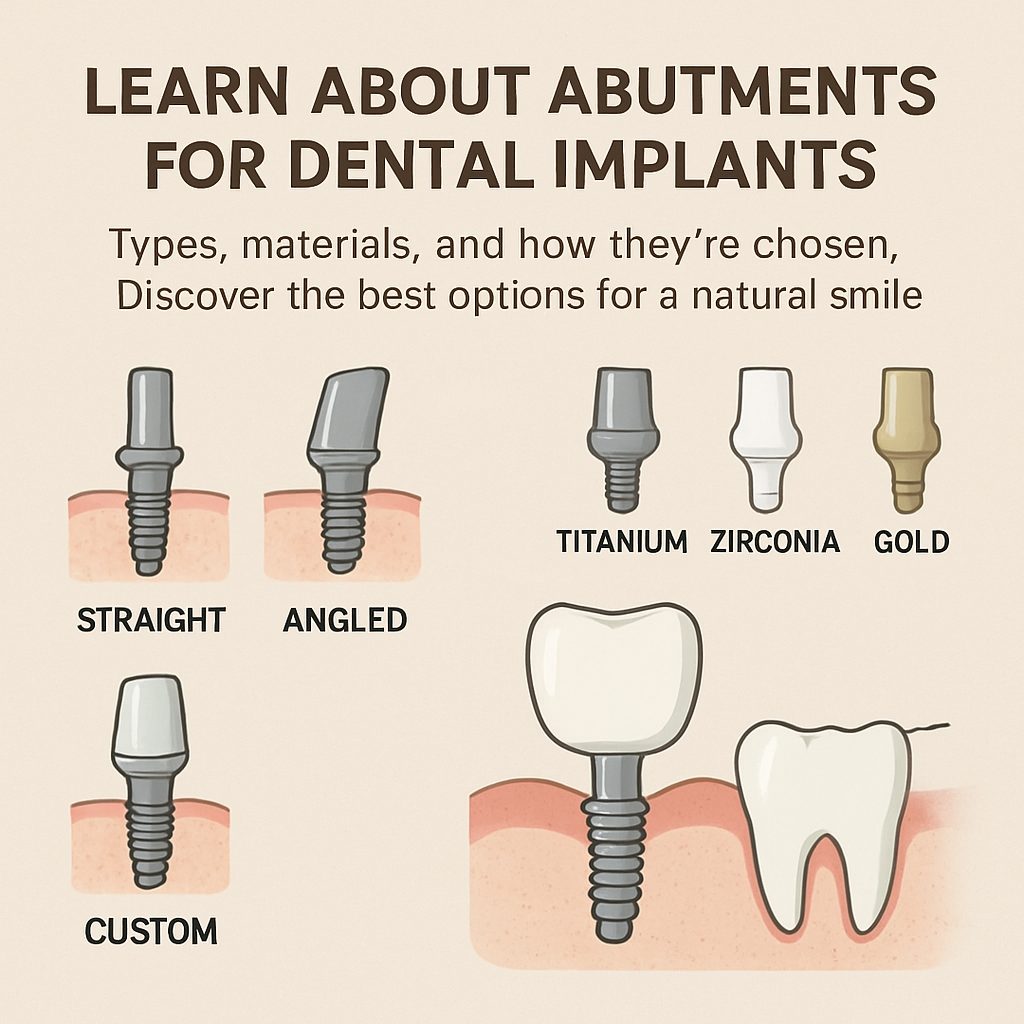Abutments for dental implants are the small but essential connectors that hold your new tooth in place. This guide explains what abutments do, the common types and materials, how they’re chosen and placed, and how to care for them so your implant looks and works like a natural tooth. If you’re considering implants, you’ll get clear next steps to discuss at your visit.
Throughout this article we’ll use plain language so you can talk confidently about abutments for dental implants in Suwanee, GA with your dentist or specialist.
What are abutments for dental implants?
An implant restoration is a three-part system: the implant fixture (the part in the bone), the abutment (the connector), and the crown (the visible tooth). The abutment sits on the implant and supports the final crown. It positions the crown for good bite and looks, seals the implant connection, and transfers chewing forces to the implant.
In short, without a well-chosen abutments for dental implants, the crown won’t fit correctly, may look unnatural, or could cause hygiene and maintenance problems. That’s why discussing abutments for dental implants early in treatment matters.
Types of abutments and when each is used
Stock vs. custom abutments
Stock abutments are pre-made in common sizes. They work well when your implant angle and gum shape are straightforward. Custom abutments are designed for your exact mouth using lab work or CAD/CAM milling. They are chosen when:
- Esthetics are critical (front teeth)
- Implant angulation needs compensation
- Gum contours require a precise fit for a natural emergence profile
Custom abutments often give a better long-term fit and a more natural look, though they can cost more and take longer to make.
Materials: titanium, zirconia, and gold
Common abutment materials each have trade-offs:
- Titanium — Very strong and highly biocompatible. Good for back teeth and high bite forces. It can show a grayish tint under very thin gums.
- Zirconia — Tooth‑colored and ideal in the esthetic zone (front teeth). It’s strong but can be slightly more brittle than titanium in extreme forces.
- Gold (or gold alloys) — Biocompatible and durable. Less common today for visible areas due to color.
Screw-retained vs. cement-retained abutments
Screw-retained abutments allow the crown to be removed easily by the dentist if repairs or adjustments are needed. They’re preferred when access and retrievability are important. Cement-retained abutments use dental cement to attach the crown and can offer a cleaner esthetic with no visible screw access, but excess cement can cause gum inflammation if not perfectly managed. Your dentist will weigh retrievability, esthetics, and maintenance when choosing between them.
How abutments for dental implants are chosen and placed
Typical steps in selection and placement:
- Clinical exam and imaging (X-rays or CBCT) to assess bone and gum tissue height and thickness
- Digital impressions or traditional models to plan the final tooth
- Choosing material, shape, and retention type based on esthetics and bite
- Fabrication (stock selection or CAD/CAM/lab custom build)
- Abutment try-in or placement and final crown attachment
Key selection factors include gum tissue height and thickness, bite forces (how hard you chew), whether the tooth is in the esthetic zone, and patient habits like clenching or grinding. After placement, keep the area clean, watch for signs of trouble (looseness, unexplained pain, swelling, persistent bleeding, or bad taste), and call your dentist if any of these occur.
When discussing options locally, ask specifically about abutments for dental implants in Suwanee, GA so your specialist can explain choices that match your mouth and lifestyle.
Why trust a specialist for abutments: Dr. Melody Schiffer, DMD
Dr. Melody Schiffer is a board-certified periodontist with advanced implant training at NYU and experience as NYU faculty. As a diplomate of the American Board of Periodontology and a national lecturer, she focuses on predictable implant restorations, precise abutment selection, and patient comfort. Her training helps ensure abutment choices balance strength, esthetics, and long-term health.
If you have questions about fit, material, or which retention style suits you, bring them to your consult. A focused discussion can help you choose the best abutments for dental implants and get a lasting, natural result.








